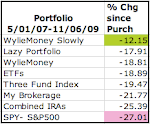I picked 20 funds, all available through one broker (Etrade) over several months and hypothetically invested $50,000 on May 1st. But I also wanted to see what the performance would be like if I invested slowly- one fund a month, over 20 months.
My approach is to invest in the fund on the first day of each month that the category I plan to add to is down for the day, "placing the order to buy at about 3:45" so I invest at the closing price for that day. Since August is almost upon us, it is time to get ready for my forth pick.
The next category I originally chose was Large Cap Growth and I originally picked JAGIX, Janus Growth and Income. But just because it was the best low cost fund Etrade had when I last looked, that does not mean this is still the case so I'm going to take another look.
When I screen out based on my criteria, low cost, low turnover, low investment minimums, etc. I get 7 options. JAGIX is listed 3rd when sorting by 3 year return. I like it over TEQUX given its lower fees. It has also done better than TEQUX over the last year and over 10 years. JAGIX struggled a bit recently (I actually own this one). It had nice returns, but not as nice as it should have, given the market trends, but despite that it remains a 5 star fund and has a nice record.

AMAGX is definitely worth a closer look. It has a higher expense ratio but has more than made up for it with much higher returns. It is riskier and is a straight growth play compared to JAGIX which also seeks income. JAGIX is actually top loaded with banks right now and is drifting toward the blend category, as a result. Citigroup is in its top 10 holdings and JP Morgan and US Bancorp are both in the top 25.
I'm going to stick with JAGIX, primarily because it WAS my original pick and is still the option with the lowest expenses. If I were actually investing money, I would think long and hard about AMAGX especially given the big picture of what a 20 fund portfolio like this would look like. I do not like the higher expenses, but the manager has a very long record of serious performance. I wish Etrade posted when they started offering this fund as a NTF (No transaction fee) offering.
Anyway, part of my strategy and inspiration for tracking these portfolios is to see if I can be only slightly less lazy than the lazy indexers, and beat them. So when given a couple of good options, I have tended to go with the less expensive choice and I have not spent a lot of time stressing over the details.


























